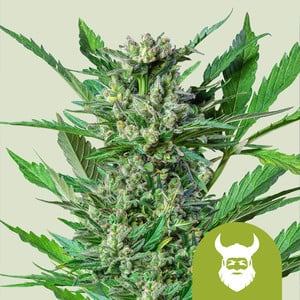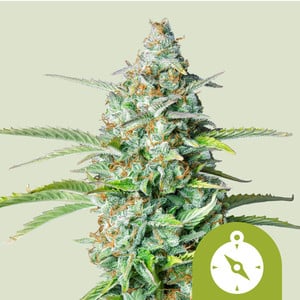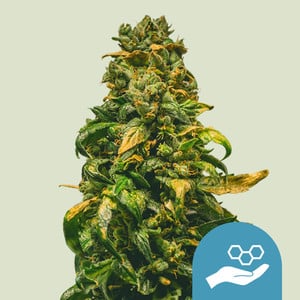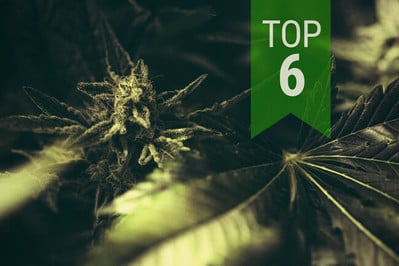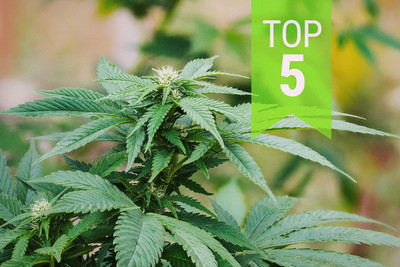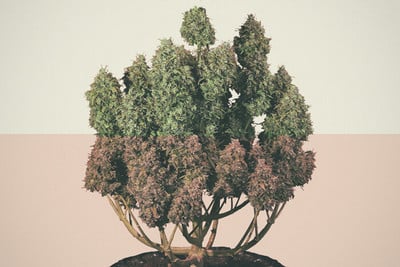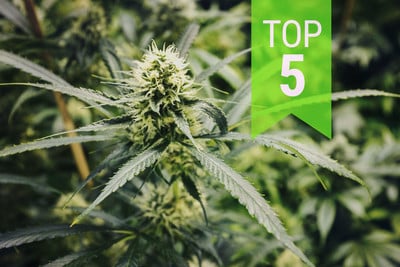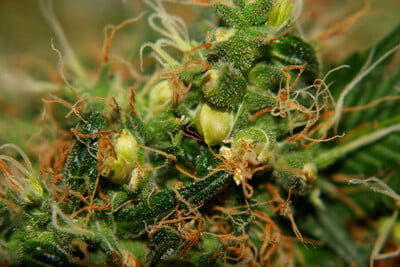.

Cannabis Ruderalis: Rugged Weed With A Hidden Talent
Cannabis ruderalis has humbly remained the underdog of the three major cannabis subspecies. However, it is now making its name known and gaining well-earned respect by bringing autoflowering genes to the scene.
When talking about cannabis strains, most will likely think of the two predominant subtypes: indica and sativa.
However, most everyday consumers aren’t aware that there is a lesser known type of cannabis that has transformed the world of cultivation and strain creation: Cannabis ruderalis.
Contents:
What is Cannabis Ruderalis?
So, what is ruderalis? To answer that question, let’s travel back to the origin of this unique type of cannabis.
Ruderalis Origins
Cannabis ruderalis is thought to have originated thousands of years ago in areas of Asia, Central and Eastern Europe, and specifically Russia, where it continues to grow as a “weed” today.
Botanists named it “ruderalis” (the word “ruderal” meaning something that grows on waste ground or among rubbish) to classify it as a type of cannabis plant with a weedy nature that escaped human cultivation and adapted to the extreme environments found in these climates.
Ruderalis is often described as the third type of cannabis along with Cannabis sativa and Cannabis indica, although botanists are unsure whether it qualifies as a species in its own right. Genetically, Cannabis ruderalis is somewhere between indica and sativa varieties.


Is Ruderalis the Same as Hemp?
Hemp isn’t a different species of cannabis. We use the term “hemp” to refer to a type of selectively bred cannabis that contains minimal THC levels. To qualify as hemp, cannabis in the US needs to contain less than 0.3% THC. In Europe, the threshold is between 0.2–0.3% THC depending on the country.
Even though Cannabis ruderalis has very low levels of THC (below 3%), it still has more than hemp. However, hemp and ruderalis often contain similar CBD levels, although these vary too.
Hemp is also a more versatile plant than ruderalis. Humans have cultivated hemp for millennia, using it for many different purposes, from making fabrics and paper to food, biofuel, and health supplements.
Ruderalis, on the other hand, is a type of cannabis used almost exclusively for one purpose: breeding.
Is Ruderalis Legal?
In order to be classified as hemp, ruderalis would need to contain a THC content below the legal limits mentioned above. Otherwise, ruderalis would only be considered legal in areas where recreational and/or medical cannabis can be grown and purchased.
Sativa, Indica, and... Ruderalis!
So, what are the differences between Cannabis indica, sativa, and ruderalis? Let’s take a quick look to compare their characteristics.
- Sativas

Grow best in hot climates with ample sun. Plants grow slim and tall with long, thin, finger-like leaves. Expect heights exceeding 3m and a cerebral “head high” that is energetic, creative, uplifting, and euphoric. Best for daytime use.

Grow best in hot climates with ample sun. Plants grow slim and tall with long, thin, finger-like leaves. Expect heights exceeding 3m and a cerebral “head high” that is energetic, creative, uplifting, and euphoric. Best for daytime use.
- Indicas

Better suited for colder climates. More robust with better resistance. Plants grow shorter and bushier with wider leaves. Indicas tend to induce a body high that is physically relaxing and "Stoning". Great as a sleeping aid and appetite stimulator. Best for nighttime use.

Better suited for colder climates. More robust with better resistance. Plants grow shorter and bushier with wider leaves. Indicas tend to induce a body high that is physically relaxing and "Stoning". Great as a sleeping aid and appetite stimulator. Best for nighttime use.
- Hybrids

A mix of sativa and indica genetics. They grow vigorously with good resistance. Can display qualities of both indica and sativa in growing characteristics and effects.

A mix of sativa and indica genetics. They grow vigorously with good resistance. Can display qualities of both indica and sativa in growing characteristics and effects.
- Ruderalis

Wild cannabis that has adapted to extreme environments. Very short and compact plants with small, chunky buds. Grows as a weed even “among rubbish” and is extremely robust with good resistance. Contains little (<3%) THC but has high levels of CBD.

Wild cannabis that has adapted to extreme environments. Very short and compact plants with small, chunky buds. Grows as a weed even “among rubbish” and is extremely robust with good resistance. Contains little (<3%) THC but has high levels of CBD.
Ruderalis: The Original Autoflowering Cannabis
In the past, ruderalis didn’t really have a significant role. It isn’t valuable for agricultural or recreational use. So, why did people start using it? Well, we have yet to mention ruderalis' most sought-after quality; the one that has made it a new staple in the cannabis community. Unlike sativa or indica, ruderalis doesn’t rely on daylight hours to bloom, instead blooming based on age.
Autoflowering weed plants flower on their own after around ~3–4 weeks of vegetative growth. Cannabis ruderalis likely developed this autoflowering trait as a response to the considerably short summers yet long daylight hours (22–24 hours) of its native habitats.
Thanks to this autoflowering capability, ruderalis can be used to breed new cannabis strains. Although it may not be desirable for recreational or medicinal purposes on its own, when crossed with high-quality indica/sativa/hybrid cultivars, ruderalis can endow the resulting strain with the autoflowering trait. This significantly reduces stress on the grower, allowing them to keep plants under a consistent 18–20-hour light schedule throughout all phases of growth.
Aside from light schedule, autoflowers offer the advantage of a faster overall grow cycle. This lessens the threat of losing good cannabis to bad weather and allows growers the opportunity to harvest multiple crops per season and per year. Beginner growers and experienced cash-croppers alike have taken to autoflowers (and therefore ruderalis) for these very reasons.
| Fast Facts on Ruderalis | |||||
|---|---|---|---|---|---|
| Appearance | Yield | ||||
|
• Short and bulky, fewer branches • Wide, 3-fingered leaves • Small buds • 1.6 – 2 feet in height |
• Low yields, “popcorn” buds | ||||
| Effects | Autoflowering | ||||
|
• Barely psychoactive (below 3% THC) • Contains some CBD for sub-perceptual effects |
• Spends ~3–4 weeks in vegetative growth • Blooms independently • Ready to harvest around 70–110 days from seed |
||||
| Fast Facts On Ruderalis | |||||
|---|---|---|---|---|---|
| Appearance | Yield | ||||
|
• Short and bulky, fewer branches • Wide, 3-fingered leaves • Small buds • 1.6 – 2 feet in height |
• Low yields, “popcorn” buds | ||||
| Effects | Autoflowering | ||||
|
• Barely psychoactive (below 3% THC) • Contains some CBD for sub-perceptual effects |
• Spends ~3–4 weeks in vegetative growth • Blooms independently • Ready to harvest around 70–110 days from seed |
||||
Ruderalis Genetics: Autoflowering Strains From Royal Queen Seeds
At Royal Queen Seeds, we breed autoflowerg strains using the best genetics to ensure excellent performance and results.
1. Royal Dwarf

Royal Dwarf is a short, stout, fast-growing autoflower that’s excellent for indoor cultivation. Staying at a convenient 1.3 – 2 feet, this “bonsai” among cannabis fits everywhere. The sativa-dominant variety is ready in just 8–9 weeks from seed. The girl is supercharged with potent Skunk genetics and has a social, uplifting effect that she rounds off with a relaxing and soothing stone.
Royal Dwarf
|
|
Skunk x Ruderalis |
|
|
5 to 7 oz/m² |
|
|
1 to 2 feet |
|
|
6 - 7 weeks |
|
|
THC: 13% |
|
|
Sativa 10% Indica 60% Ruderalis 30% |
|
|
1 to 3 oz/plant |
|
|
2 to 3 feet |
|
|
9 - 10 weeks after sprouting |
|
|
Creative, Motivating |
2. Northern Light Automatic

One of the most popular Afghani-derived indicas, this autoflowering variety won’t get taller than 3.3 – 3.9 feet and races to harvest in 9–10 weeks. Northern Light Automatic has a nice, sweet taste and a very relaxing effect with a slightly heady, happy note. Great for medicinal users as a sleep aid. Good yields of 19.4 oz/m² indoors and 7.1 oz outdoors will make growers very happy!
Northern Light Auto
|
|
Northern Light x Ruderalis |
|
|
18 to 19 oz/m² |
|
|
3 to 4 feet |
|
|
6 - 8 weeks |
|
|
THC: 14% |
|
|
Sativa 0% Indica 80% Ruderalis 20% |
|
|
6 to 8 oz/plant |
|
|
4 to 5 feet |
|
|
10 - 12 weeks after sprouting |
|
|
Clear, Uplifting |
3. Solomatic CBD

Solomatic CBD is the first CBD-rich strain from our catalog to feature an impressive CBD:THC ratio of around 22:1! Unlike many other CBD-rich strains, this strain is sure to never contain more than 1% THC. Yet, she boasts a staggering 21% CBD, which makes her ideal for medicinal users and those with little tolerance for THC. Vaping her will inspire pure joy thanks to her sweet and fruity flavor accented by hints of ginger and pine.
Solomatic CBD
|
|
Diesel CBD x Asia CBD Auto |
|
|
5 to 7 oz/m² |
|
|
2 to 3 feet |
|
|
7 - 8 weeks |
|
|
THC: 1% |
|
|
Sativa 20% Indica 70% Ruderalis 10% |
|
|
1 to 3 oz/plant |
|
|
2 to 3 feet |
|
|
10 – 11 weeks after sprouting |
|
|
Clear, Light |
Tips for Growing Autoflowering Cannabis
Did we make you curious about growing autoflowers? Follow these tips to look forward to a successful grow with plenty of fat buds come harvest!
- Don’t repot your autoflowers: Autoflowers don’t have time to recover from stress. Start plants in their final pot.
- Use a root stimulator: Because the lifespan of autoflowers is limited, a root stimulator can help optimise development.
- Use light and airy soil: Don’t make it difficult for your autoflowers to grow and expand their roots. Encourage fast growth by using light and airy soil.
- Use a big-enough container: Autoflowers won’t grow too tall, but a pot that’s too small will negatively affect growth and yield.
- Don’t overdo it with water and nutrients: Autoflowers need less water and fewer nutrients than feminized cannabis. Don’t overdo it.
- Watch out for pests: Good thing autoflowers grow fast, so there is less risk for pest infestations. But, you should still check for pests when growing outdoors in particular. Insecticidal soap and neem oil can do wonders to eradicate many common cannabis pests.
You can find more tips on growing autoflowers indoors here, and tips on growing autoflowers outdoors here!
More Info at Royal Queen Seeds
Want more info on all things autoflowering? Take a look at our blogs on maximising your autoflowering yield, the pros and cons of autoflowers, and our top 10 autoflowering strain recommendations. RQS has all the info you need!


























